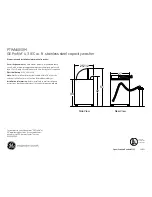
9
Important Trailer Safety Information
Add the missing pounds of air pressure to each tire that
is under inflated.
Check all tires to make sure they have the same air
pressure.
If you have been towing your trailer and think that a tire
is under inflated, fill it to the recommended cold inflation
pressure indicated on your trailer's tire label placard or
the VIN label. You can also check the sidewall of the
tire for a correct tire inflation pressure. Your tire will
have a slightly lower air pressure because the tire is
warm when you are inflating it, but it will be much better
than to continue to tow it with the under inflation it may
have had. Once the trailer has been parked long
enough to allow the tires to cool down, recheck the tire
pressure and add additional air to return the tire
pressure to the recommended level.
Tire Size
To maintain the trailer's carrying capacity and safety,
purchase only the same size tires as what were origi
-
nally supplied on the trailer.
Safety Tips
Slow down if you have to go over a pothole or other
object in road.
Do not run over curbs and try not to strike the curb
when parking.
For a free brochure visit:
www. nhtsa.dot.gov
IMPORTANT: Before towing this trailer be sure to
read the instructions and warnings supplied in this
manual. Also read the information supplied with
your tow vehicle so you know and understand it's
limitations.
Never Tow the Trailer Before Checking:
•
Coupler and latch assembly show no signs of
wear or damage.
•
Coupler hitch and hitch ball are of the same
size.
•
Coupler and safety chains are safely secured to
the hitch.
•
Check all fasteners for proper tightness.
•
Load is securely tied down to the trailer.
•
Wheel lug nuts are properly tightened to the
right torque.
•
Wheel bearings are properly adjusted and
maintained.
•
Load is within the maximum load carrying
capacity of trailer.
•
Tires are properly inflated and are road worthy.
•
All trailer lighting is working properly.
•
Tire pressure and tire condition
•
Wheel lugs*
•
Bearing lube and tightness
•
Hitch
•
Safety chains
•
12V running lights
•
Distribution and security
•
Caster up in travel position
* Check lug nuts for tightness before initial trip, at 10
miles, 25 miles and 50 miles. Recheck every 3 months
or 3000 miles.
NOTE: Checking all of the above steps before every
trip is key for safety.
IMPORTANT: The load must be distributed equally
on the bed of the trailer if possible. Heavy, concen
-
trated loads may cause damage or possible failure
of the trailer.
WARNING: Loads place on the trailer must be
securely tied to the trailer. Always use appropriate
tie downs designed to restrict loads from moving
when properly attached. Failure to do so will allow
shifting of the load causing potential trailer failure
and/or loss of the load and personal injury.
This trailer is equipped to meet all applicable federal
safety standards in effect the day of manufacture.
Check local and state requirements regarding any addi
-
tional equipment that may be required.
The addition of optional equipment to your trailer may
in- crease the total weight of your trailer package to
where it now exceeds the maximum load carrying
capacity of the trailer.
Landa ECOS 7000 Operator’s Manual 9.801-316.0 - E










































